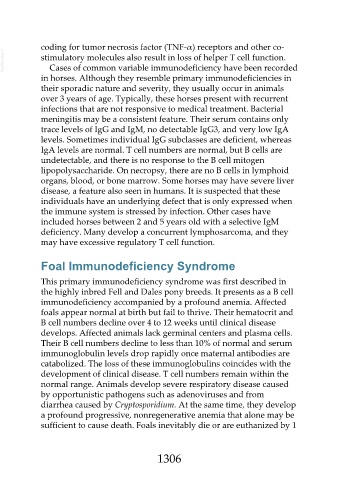Page 1306 - Veterinary Immunology, 10th Edition
P. 1306
coding for tumor necrosis factor (TNF-α) receptors and other co-
VetBooks.ir stimulatory molecules also result in loss of helper T cell function.
Cases of common variable immunodeficiency have been recorded
in horses. Although they resemble primary immunodeficiencies in
their sporadic nature and severity, they usually occur in animals
over 3 years of age. Typically, these horses present with recurrent
infections that are not responsive to medical treatment. Bacterial
meningitis may be a consistent feature. Their serum contains only
trace levels of IgG and IgM, no detectable IgG3, and very low IgA
levels. Sometimes individual IgG subclasses are deficient, whereas
IgA levels are normal. T cell numbers are normal, but B cells are
undetectable, and there is no response to the B cell mitogen
lipopolysaccharide. On necropsy, there are no B cells in lymphoid
organs, blood, or bone marrow. Some horses may have severe liver
disease, a feature also seen in humans. It is suspected that these
individuals have an underlying defect that is only expressed when
the immune system is stressed by infection. Other cases have
included horses between 2 and 5 years old with a selective IgM
deficiency. Many develop a concurrent lymphosarcoma, and they
may have excessive regulatory T cell function.
Foal Immunodeficiency Syndrome
This primary immunodeficiency syndrome was first described in
the highly inbred Fell and Dales pony breeds. It presents as a B cell
immunodeficiency accompanied by a profound anemia. Affected
foals appear normal at birth but fail to thrive. Their hematocrit and
B cell numbers decline over 4 to 12 weeks until clinical disease
develops. Affected animals lack germinal centers and plasma cells.
Their B cell numbers decline to less than 10% of normal and serum
immunoglobulin levels drop rapidly once maternal antibodies are
catabolized. The loss of these immunoglobulins coincides with the
development of clinical disease. T cell numbers remain within the
normal range. Animals develop severe respiratory disease caused
by opportunistic pathogens such as adenoviruses and from
diarrhea caused by Cryptosporidium. At the same time, they develop
a profound progressive, nonregenerative anemia that alone may be
sufficient to cause death. Foals inevitably die or are euthanized by 1
1306

